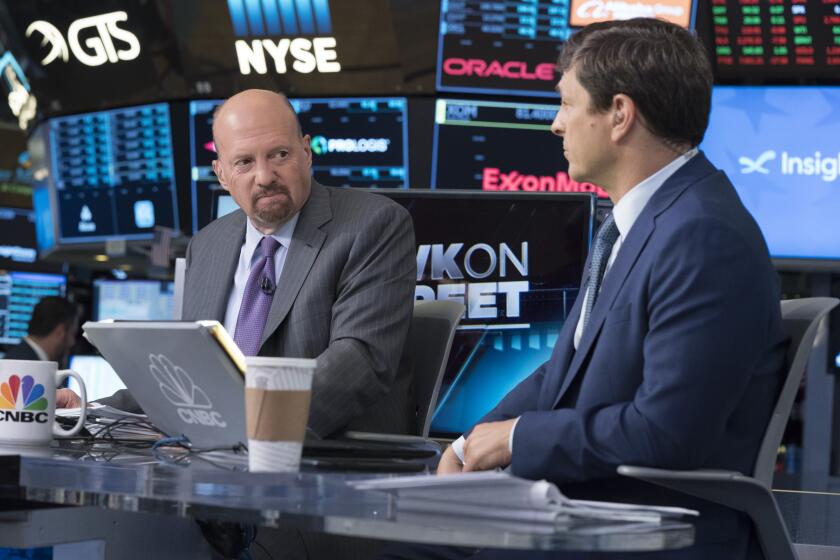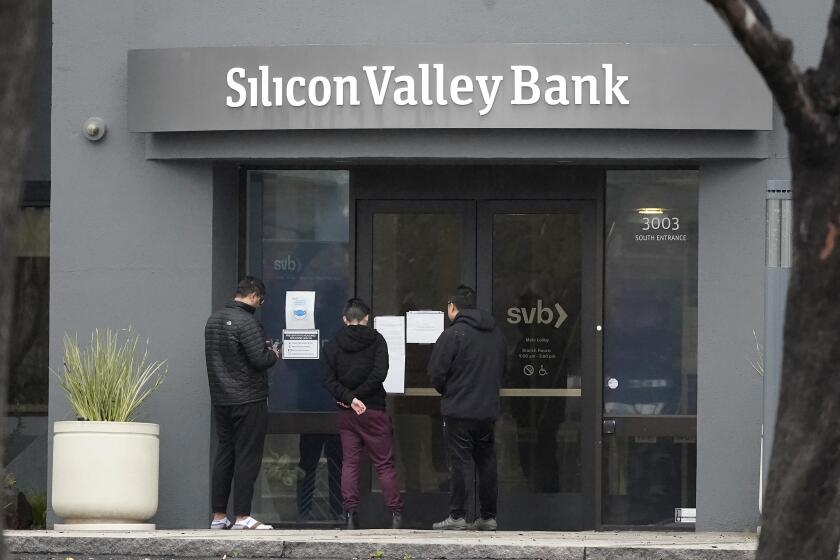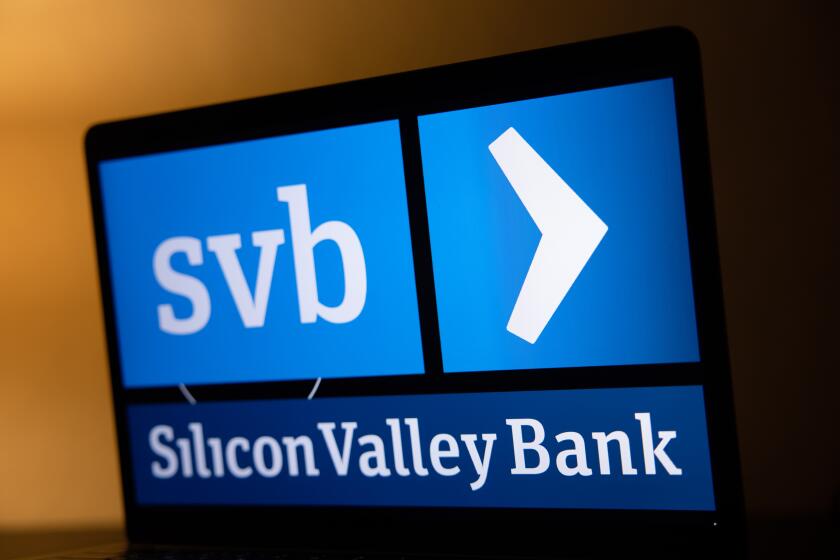Column: The Fed’s errors have brought the economy to the brink of recession. Raising rates again might send it over

- Share via
The Federal Reserve system was stung in late 2021 when it declared signs of emerging inflation to be “transitory” and delayed taking strong action to tamp down price increases.
The central bank has been running from its critics ever since. Under its chairman, Jerome H. Powell, it has instituted the most aggressive anti-inflation interest rate increases in more than 40 years as if to make up for its initially laggard response to what proved to be a nearly yearlong run-up in prices.
In the process, however, the Fed has inflicted damage on bank balance sheets that could have more-lasting negative effects on economic growth than would be felt from even a sustained period of high inflation.
I’m just one more sleepless night away from taking my core macro forecast from no growth to outright recession, and if that is the most likely outcome, why on earth would the Fed keep raising rates?
— Economist Ian Shepherdson
The harvest is a banking crisis triggered by the failure on March 10 of Silicon Valley Bank, or SVB, and the subsequent run on several other banks in the U.S. and overseas.
At this moment, as Fed officials prepare for a two-day meeting at which they will decide whether or by how much to raise rates, expectations in the Fed-watching community are that the bank will slow the pace of its recent increases by announcing a hike of only a quarter of a percentage point on Wednesday. That would bring its total increases to 4.75 percentage points in the space of just one year.
Get the latest from Michael Hiltzik
Commentary on economics and more from a Pulitzer Prize winner.
You may occasionally receive promotional content from the Los Angeles Times.
Some economists and policy experts are counseling that the bank shouldn’t raise rates at all this week, however, lest it tip the economy into recession.
There are several reasons: The Fed’s interest rate increases have already brought about signs of a slowing economy, businesses and families that were flush with cash last year thanks to government assistance have spent down their financial cushions, and the banking crisis is almost certain to prompt banks to tighten their lending standards, adding another head wind to economic growth.
“The interest rate shock is still there ... and we’ve got the banking crisis on top, and we’ve got a smaller stock of savings,” Ian C. Shepherdson, chief economist of Pantheon Macroeconomics, said during a webcast Monday. “I’m just one more sleepless night away from taking my core macro forecast from no growth to outright recession, and if that is the most likely outcome, why on Earth would the Fed keep raising rates?” Shepherdson said that if he could advise Fed officials directly, he’d tell them: “Please don’t.”
Former FDIC Chair Sheila Bair, who was in place during the 2008 banking crisis, added her voice to the chorus in an interview Sunday with CNN. “The Fed needs to hit pause and assess the full impact of its actions so far before raising short rates further,” she said. “If they paused, it would have a settling effect on the markets.”
Economists’ concerns about the scale and speed of the Fed’s rate increases have been building for months. Former Fed economist Claudia Sahm has long warned that “the Fed’s large and rapid rate hikes during the past year were going to break something in financial markets,” as she wrote on her blog last week. “The meltdown at SVB and the possible contagion effects fit the bill.”
Silicon Valley Bank telegraphed that its securities holdings were underwater. Why didn’t the regulators act sooner?
There’s reason to believe that the battle against inflation has largely been won, though at some economic cost. Two important drivers of price increases in 2022 — a spike in oil prices after Russia’s February 2022 invasion of Ukraine, and a strain on global industrial supply chains as pandemic shutdowns ended and demand rebounded — are no longer in place.
Business lending is slowing, housing prices are still in a downturn, wage increases are fading and manufacturing output is shrinking. These metrics all point to a deflationary slowdown.
The Fed’s difficulties in managing economic upheaval over the last year stem partially from its multiple incompatible responsibilities.
Economically speaking, the most important of these is what’s known as its “dual mandate” — to foster both maximum employment and price stability. This means using its authority over monetary policy to keep inflation curbed and to promote “the highest level of employment that the economy can sustain over time,” in the words of the Federal Reserve Bank of St. Louis.
Those goals are generally seen as complementary, for low and stable inflation tends to support job growth. But there are times when they can come into conflict, as when aggressive anti-inflation policies lead to higher unemployment. That’s a prospect that Fed critics have raised during the aggressive rate hikes of the last year, which aimed to bring down inflation by slowing the economy, which has begun to produce mass layoffs in high-tech and other sectors.
Then there’s the Fed’s role as chief regulator of much of the banking system, specifically bank holding companies (which own nearly all commercial banks of any size) and many state-chartered banks. The central bank’s role here is to protect the “safety and soundness” of individual banks and the banking system as a whole.
Over the last year, the Fed’s duties as an inflation fighter and a bank regulator have been at cross purposes. Starting last March, it made the first responsibility its priority, without watching very closely how its rate hikes — the fastest pace of increases since those instituted by Fed Chair Paul Volcker over 17 months in 1979-80 — would affect banks’ safety and soundness.
The Fed seems to have overlooked that the rate hikes would create a problem for banks completely different from the issues that brought the banking system to the brink of meltdown during the financial crisis of 2007-09.
Demands by the tech industry’s most vocal libertarians for a government bailout of Silicon Valley call to mind the old saw: The goal in business to privatize profits and socialize losses.
Then, the bursting of the housing bubble in the U.S. trashed the value of mortgages and mortgage-backed securities that the banks held, much of which had been overvalued from the start.
The remedy imposed by Congress and the Fed was to force the banks to rebuild their capital cushions by reducing how much they could lend out as a multiple of equity ownership and deposits, and to improve the quality of the loans they issued. Among other things, the subprime mortgage market — lending to home buyers who would not qualify for mortgages under traditional terms — was all but wiped out.
By that standard, U.S. banks are far healthier today than 15 years ago. That included Silicon Valley Bank even at the time of its meltdown and takeover by the Federal Deposit Insurance Corp. this month.
The roots of the current crisis, however, are completely different. SVB’s problem was not risky loans or bad assets. Its nearly $194 billion in tangible assets as of the end of 2022 included nearly $116 billion in U.S. and foreign government securities of unquestioned safety, plus nearly $14 billion in cash and an additional $74.3 billion in outstanding loans.
That should have been more than enough to cover the bank’s $173.1 billion in deposits. The problem, as we’ve reported before, is that the bank purchased most of those government securities at the very peak of the bond market, when interest rates were close to zero and bond prices were therefore likely to go nowhere but down. By the beginning of this year, they were worth much less than the bank had paid for them.
That shouldn’t have mattered much, however. The securities holdings were divided into two categories — about $25.3 billion were listed as “available for sale,” which meant their decline in value had to be disclosed on the bank’s balance sheet, and $90.6 billion as “held to maturity.”
Accounting rules allow the latter to be valued at cost, because it’s understood that once they reach their maturity dates they’ll be worth the price paid, plus interest. By the end of last year, the unrealized losses on the held-to-maturity portfolio — which would matter only if the securities had to be sold before they matured, came to nearly $15.2 billion.
The unexpected factor causing the bank’s collapse was that its deposits were highly concentrated in one business sector — venture-backed startups in high tech and biotech. When venture investors advised their portfolio companies to pull their deposits out of SVB, prompting an outflow of some $42 billion in a single day, the embedded losses became relevant.
The Silicon Valley Bank failure is the old story of what happens when short-term depositors want their money back from a bank with only long-term assets.
This is the situation that the Fed apparently overlooked. It could be confident that SVB, and other banks with similar balance sheets, met the capital standards imposed after the Great Recession. But it didn’t adequately monitor the combined effect of a plunge in the value of long-term capital holdings and a sudden flight of deposits.
The Fed was fighting the last war, when risky, overvalued loans brought the banking system to its knees, but not the existing war, in which the enemy was its own campaign of boosting interest rates (and thus crashing the values of long-term bonds) to fight inflation.
The Fed, Treasury Department and FDIC have administered the only medicine they thought makes sense in this context. They’re allowing struggling banks to borrow from the Fed by valuing their long-term securities holdings for collateral at their maturity values. (The FDIC has also agreed to insure the full balance of deposits at these banks, rather than only up to the cap of $250,000 per depositor, as a way to stem the impulsive flight of deposits from all but the biggest banks.)
A further Fed rate increase on Wednesday, however, would only make the whole process somewhat more difficult. Banks’ securities holdings will decline in value more, and depositors may become more nervous about keeping their money in midsize or small banks.
The Fed’s performance over the last year has been a series of interacting, self-compounding errors. At first, the central bank and Chairman Powell underestimated the duration and intensity of inflation (and misunderstood its causes). Then they overreacted by driving rates higher and faster than the economy could sustain, without ever pausing to examine how their actions were working.
Meanwhile, they took their eyes off the bank regulatory ball. It’s true that banks of SVB’s size were granted exemptions in 2018 from many post-recession regulations, including the mandate to undergo “stress tests” that might have shown how the run-up in interest rates would affect its balance sheet. But nothing prevented the Fed from proactively making its own judgments about SVB’s health. It did not.
“The ‘transitory’ fiasco was a fiasco for everybody,” Shepherdson says. “The Fed’s reputation institutionally and Powell’s reputation personally took a real pounding from both sides of the aisle, from the media and from markets, and they cannot be wrong again.... It would be a mistake to raise rates this week, and the cost of not raising this week is very low.”
More to Read
Get the latest from Michael Hiltzik
Commentary on economics and more from a Pulitzer Prize winner.
You may occasionally receive promotional content from the Los Angeles Times.














